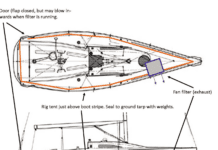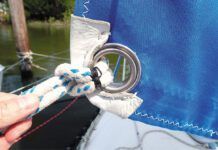Sunglasses – The Finale
I read Doug McGrigors letter in Mailport with sympathy, as my Maui Jim sunglasses also failed after a little over a year of use by delamination of the anti-reflective coating on the back of the lenses. My story ended on a better note, but not before an initially unsatisfactory reply from their warranty department. I was initially told that I could send the glasses back and they would see what they could do, but didnt sound too optimistic about a repair. They were willing to credit me for 30% off the retail price of a new pair, a suggestion I found totally unsatisfactory in light of the purchase price of their products. I did send the glasses back with a letter directed to Kim in the Warranty Repair Department. I am happy to report that they replaced the lenses free of charge. I am however concerned about what could turn into a recurrent problem with delamination of the coating on these high-priced glasses.
-Gary Bessette
Via e-mail
———-
Just a quick note of support and appreciation for your piece on sunglasses. As someone who spends a lot of time outdoors, protecting the eyes and longer term “vision” I fully embrace the sort of “quality” products you recently evaluated. $100 is a bargain for products that truly deliver less eye strain and protection. Current personal favorites are my 2 pairs of Maui Jims (one HCL and the other dark gray). I have enjoyed excellent service on both occasions it became necessary.
-Chuck Mead
Via e-mail
———-
Lexan, Boat Profiles, Etc.
Regarding your response in PS Advisor (July, 2001) I think you missed the most important factors to consider in selecting polycarbonate vs. acrylic (plexiglas) for a boat. Polycarbonate (Lexan) is stronger, can handle more shock and impact and is more scratch resistant. However it is degraded much quicker by exposure to UV and therefore acrylic is the plastic of choice for ports, hatches and companionway “boards.”
Thanks for the 2001 Sailboat Prices List. Just when Im thinking I should let my subscription lapse because of your frivolous reviews/articles (like the sunglasses evaluation), you produce something useful to a sailor.
And thanks for Nick Nicholsons Offshore Log-its great.
Finally, I would suggest you not publish a view/drawing of a sailboat that does not include the underwater form (e.g, the Pilot 35 in the July 1, 2001 issue). I realize you probably get the artwork from the manufacturers, but I suggest you insist on getting the underwater portion also. Otherwise we are missing a very significant part of the vessel.
-Jim Wills
Via e-mail
Starting with the last point first, you’re right-sometimes all we can get from a boatbuilder is a profile drawing of a boat from the waterline up. It’s all very well to insist on a full set of naval architect’s drawings, but they can’t be reproduced in a magazine at a reasonable size and with reasonable clarity without being redrawn. Boatbuilders and NAs understandably prefer to keep that process under their own control, so they produce their own graphics for the madding crowd, and we all have to go by what we’re given. We’d much prefer to show the underbody, too.
In the matter of Lexan, first, thanks for your better distinction of the generic “acrylic” label, under which Plexiglass and Lucite would fall. In the July 1 issue Mr. Schaefer wanted to know about the appropriateness of Lexan for companionway slats, not hatches. For horizontal surfaces less inclined toward the sun, especially ones that need to be impact- and scratch-resistant, and that don’t need fasteners in them, we think Lexan is a good choice. The main disadvantages, we think, will be the weight of the slats and the expense.
In fact there are plenty of Lexan hatches and ports out there, and hardware makers (Beckson and Pompanette/Bomar, to name two) still make them with Lexan precisely because on many boats high strength and impact resistance are more important than UV resistance. As hateful as it is to drop a winch handle or the end of a spinnaker pole on a foredeck hatch, it’s less hateful on Lexan. On the other hand, a good acrylic hatch lens will be lighter, cheaper, and more easily replaced than a Lexan lens. It’s always a trade-off, right?
———-
Personal Rescue Lights
I just finished reading your review of Personal Rescue Lights (July 1) and find the results somewhat disheartening, to say the least.
When I researched the market in search of a personal rescue light a couple years ago, I discovered a model that I understand sees considerable use in the fishing industry. It is the Jotron AQ4 Personal Rescue Light, made in Norway. This unit is built to take heavy abuse and is USCG-approved. Powered by 1 C-cell battery, this unit has the largest strobe I have seen in any personal rescue light. I examined practically every light you tested in your report and believe that the Jotron AQ4 is probably the best personal rescue light on the market today. I purchased mine from Fisheries Supply in Seattle for less than $100 two years ago and am totally satisfied with its construction and performance.
If at all possible, I think you would find your time well spent testing this rescue light and reporting the results back to your readers. When it comes to lifesaving equipment, we all want the very best we can afford and I believe that this is one of those products that truly delivers.
-Tom Neupert
Bainbridge Island, WA
———-
Where Credit Is Due…
To CombiTech (www.mscan.com), Middelburg, Netherlands: “Based on your recommendation on weather fax software, I downloaded both Mscan Meteo Pro and JVComm for a test drive. Neither worked on my laptop, a Sony Vaio. I wrote both makers. Very quickly (over a weekend in fact) I received a reply from the developer of Mscan Meteo Pro, Mike Versteeg. Thereafter followed a week-long communication, often two or three times daily, aimed at figuring out where the problem lay. Mike solved the problem by rewriting a section of the program to work with the somewhat non-standard Sony Vaio, and sent me new beta copies to try-which worked perfectly. In all, a stellar performance by both the Mscan Meteo Pro software and the person behind it. 5 stars.”
-Roger Williams, Jericho, VT
To Achilles USA (www.achillesusa.com), Everett, WA: “About two years ago I purchased a new Achilles inflatable-floor dinghy. I love the inflatable floor but the dinghy came with an inferior pump that would not adquately inflate the floor. I noticed recent shipments of the same dinghy came with a much improved pump. I notified Achilles U.S.A. and they immediately shippedme a new upgraded pump at no charge.”
-Dan Callen, Ooltewah, TN
To Ancor Marine (www.ancorproducts.com), Cotati, CA: “Ancor Marine replaced a ProVo meter that was three years out of warranty and reading current incorrectly. Terri Barrett asked no questions, just said “Send the old one to me. As soon as gets to my desk I’ll send a new meter to you no charge.” In a week’s time I had a new meter. Many thanks to Terri Barrett and Ancor Marine.”
-Don Ferrell, Portland OR
To Fischer Panda (www.fischerpanda.com), Ft. Lauderdale, FL: In early 2000 I installed a Fischer Panda 4.2kw genset in my Hunter 40.5. The warranty on the electrical components is 4 years, while the diesel warranty is 12 months. The diesel malfunctioned during a cruise from Tampa to Key West in early May 2001.
Despite the fact that the diesel was technically out of warranty, Fischer Panda stepped up to the plate and provided warranty coverage. Kevin McLaughlin of Fischer Panda provided excellent technical support in working with me and a mechanic in Key West to diagnose a fuel injector and fuel solenoid problem. Parts were overnighted to me in Key West without charge, and the substantial bill of the mechanic was paid by Fischer Panda without question. Fischer Panda had no legal obligation to assume this expense, and did so due to an obvious desire to ‘walk the extra mile’ in providing excellent customer support.
-Robert R. Vawter, Jr., Tampa, FL
———-
ABOS Marine Blue Book Alive and Well
Contrary to what we surmised in our June boatbuying article, “What’s She Worth,” the ABOS/Intertec Marine Blue Book price guides are still published, both in paper and on CD. Contact Intertec Publications, 9800 Metcalf Avenue, Overland Park, KS 66212 913-967-1725. www.intertecbooks.com.





































